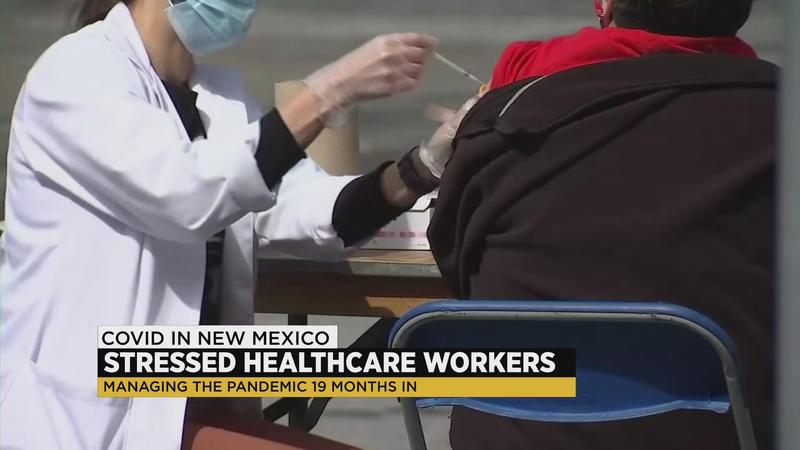New Mexico health care workers continue to see staff shortage
[anvplayer video=”5062504″ station=”998127″]
ALBUQUERQUE, N.M. – It has almost been 19 months to the day since New Mexico’s first coronavirus case was identified. A lot has changed – and while some things feel like we’re getting back to normal – the pressure on the health care system has not let up.
KOB 4’s Ryan Laughlin gives a rare look inside UNMH and how the challenges have evolved for frontline workers.
Christine Richardson’s family lives in northeast Albuquerque and they are your typical happy family.
"This is Violet, she’s 7 and she’s in second grade. And this is my husband, Martin,” said Richardson.
In the Richardson household it’s already spooky season.
"Nightmare Before Christmas is just one of our favorites.”
But Richardson has been living through a different type of nightmare at work. She has been a registered a nurse for three years at UNM Hospital.
"I had to step up and lead seasoned nurses through this pandemic. And so that was hard. A year ago, we were stressed out, not about the workload. We were stressed out about not knowing what was going to happen,” said Richardson.
She oversaw nurses working outside the COVID units and even they felt the impact of the pandemic.
"Nobody ever mentions those Med Surge Nurses that were, you know, down there in the trenches with the rest of the population. When that whole part was over. None of us had time to reflect, and so that’s sad. So as a leader, my job is to try to stay positive and and and remind them to reflect. And so just that part that we – it was over, but we didn’t reflect. We just kept moving on,” she said.
Moving on to the new challenge: an unrelenting workload. New Mexico ICU occupancy is one measurement of how stressed our health care system is. In the summer of 2020 – around 70% of the state’s ICU beds were full. A massive COVID surge made things worse in the winter – then a little better – but now more than a year after the pandemic began – over 80% of the state’s ICU beds are still full.
But it’s not just COVID anymore, if you look at the ICU space next to COVID cases over the same time – you can see COVID cases fell – but people with other illnesses still kept filling ICU beds.
Richardson explains how the hospitals are split up into units, and as supervisor of a unit she would typically take a couple patients.
"Every day we’re critically staffed, meaning, we have one or two less people that we need on the unit. If I’m on my unit that has 12 patients on it and I only have two nurses and myself, then I’ll be taking three of those patients,” she said.
That leaves more patients per nurse, which is not ideal.
"Because there’s other things that we’re supposed to be doing. Also, sometimes it could be unsafe if you don’t have enough staff,” said Richardson.
"These increased patient ratios are causing burnout between the nurses,” said Jeanine Gamboa, traveling nurse.
Gamboa is a traveling nurse that works with COVID patients – a position in-demand over the last 19 months.
“You know, so many people are quitting and regular staff are quitting. And you’re having to fill these roles and that takes time and it leaves the floor really stressed,” said Gamboa.
Both Gamboa and Richardson know nurses who have walked away from the profession during the last year and half. The latest numbers from the state’s Department of Workforce Solutions show a staggering 13,000 job postings in health care and social assistance.
At UNMH they have over 140 job openings for registered nurses alone. Despite the critical staffing designation, Richardson said people putting off care are adding pressure.
"There’s so many patients to care for. And there still are COVID patients taking up a unit that could be for these patients that are in the hall or in the surge,” she said.
With the latest Delta surge trending down and vaccinations ticking up – what are these nurses anticipating for the months ahead?
"I’m little scared, to be honest with you, not knowing when it’s coming again. You know, you can listen to the news and, you know, different states closing down. And we know the flu season is upon us and it’s approaching quickly of, you know, we’re in October now,” Gamboa said.
"I don’t anticipate anything being less than it is now. Which is a lot,” Richardson said.
As parts of people’s lives return to normal – the situation inside hospitals has not. Christine said she’s tired – but – her support system – at work – and at home have helped her get here.
“I look at it more like I am more empowered than I’ve ever been as a nurse right now in this moment because of that situation,” she said. “And I know a lot of the nurses that I work with are too. Even if they don’t feel that I can see it in them, I can see just how much of a how powerful they are as a person and as a nurse now."
The pandemic persists – but so do New Mexico’s health care workers.
